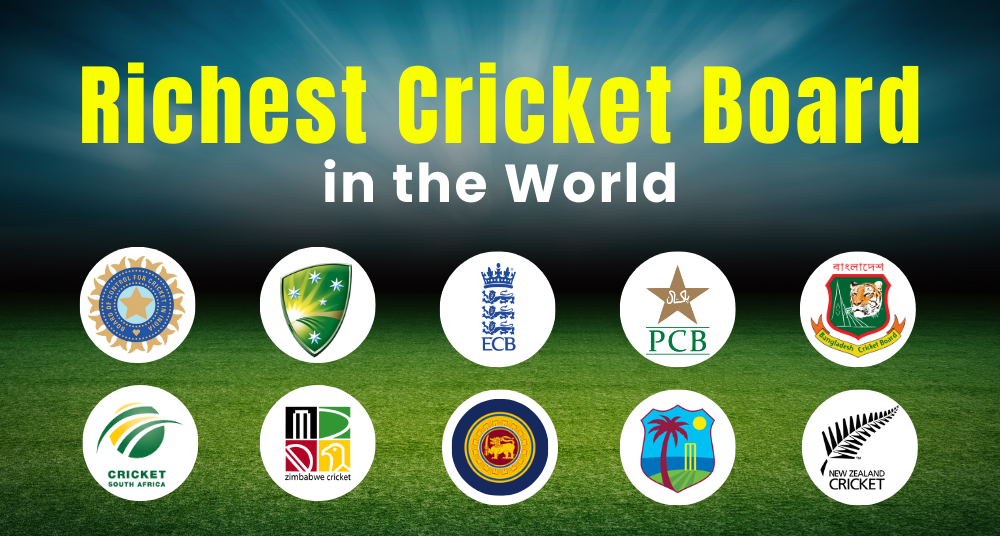Cricket is not just a sport; it has evolved into one of the most lucrative industries globally, with billions of fans and massive financial investments. Cricket boards across the world earn huge revenues through broadcasting rights, sponsorship deals, ticket sales, merchandise, and especially T20 leagues. At the center of this financial empire stands the richest cricket board in the world, the Board of Control for Cricket in India (BCCI), whose dominance is unmatched.
The BCCI net worth alone surpasses the combined wealth of several other boards, thanks to the Indian Premier League (IPL), global sponsorships, and a massive fan base. In this article, we rank the world richest cricket board and explore how these organizations generate income, invest in cricket development, and shape the future of the game. From BCCI to smaller boards, here’s a detailed look at the richest cricket board rankings for 2025.
Overview of Global Cricket Economy
Cricket as a Global Business
The cricket economy has transformed into a multi-billion-dollar industry, driven by sponsorship deals, broadcasting rights, and global fan engagement.
World Richest Cricket Board Leadership
The BCCI net worth dominates the global cricket market, with India contributing the largest share of revenue, making it the richest cricket board in the world.
Broadcasting Rights Revenue
A significant portion of earnings comes from selling TV and digital streaming rights for ICC events, bilateral series, and domestic leagues like the IPL and BBL.
Sponsorship and Advertising
Global brands invest heavily in cricket boards, offering title sponsorships, team endorsements, and advertising rights that boost financial strength.
League Cricket Impact
T20 leagues such as IPL, BBL, PSL, and CPL generate millions annually, benefiting not just the world richest cricket board but also smaller boards.
ICC Revenue Sharing
The International Cricket Council distributes profits from World Cups and international tournaments, ensuring all boards receive financial support.
Merchandise and Ticket Sales
Sales of team jerseys, accessories, and match tickets further increase board income globally.
Digital & Social Media Growth
The shift towards OTT platforms and social media promotions has opened new revenue streams for cricket boards worldwide.
Overall Economic Impact
Cricket’s financial ecosystem continues to grow, with the richest cricket board setting benchmarks for others to follow.
Criteria for Ranking the World Richest Cricket Boards
When determining the richest cricket board in the world, several financial factors come into play to ensure accurate rankings. The first and most significant factor is annual revenue, which includes income from broadcasting rights, sponsorship deals, merchandise sales, and ticket revenues. The second criterion is T20 league earnings, as leagues like the IPL, PSL, and Big Bash have become major revenue drivers.
Next is the ICC revenue distribution, where boards receive funds based on their market size, viewership, and performance. Commercial partnerships and corporate sponsorships also play a huge role, bringing in millions through branding rights and collaborations. Finally, income from hosting domestic and international tournaments adds to a board’s overall financial strength.
By evaluating all these parameters collectively, we can accurately rank the world’s richest cricket boards and analyze how each one contributes to the global cricket economy.
10 Richest Cricket Boards in the World
Board of Control for Cricket in India (BCCI)
- Net Worth of BCCI: ₹18,760 crore (~US$2.25 billion)
- Key Revenue Sources:
- IPL media rights (₹48,390 crore for 2023–2027)
- ICC revenue share (38.5%)
- Sponsorship deals with brands like Dream11, BYJU’s, and Paytm
- Bilateral series broadcasting contracts
The Board of Control for Cricket in India (BCCI) is the undisputed richest cricket board in the world, with an estimated BCCI net worth of over ₹18,760 crore (~US$2.25 billion). This staggering figure comes from multiple income streams, the biggest being the Indian Premier League (IPL), which generates massive revenue through broadcasting rights, sponsorships, and ticket sales.
The IPL’s latest media rights deal for 2023–2027 brought in ₹48,390 crore alone, solidifying BCCI’s dominance in world cricket. Apart from the IPL, BCCI earns from international bilateral series, ICC revenue share, merchandising, and sponsorship deals with companies like Dream11 and BYJU’s.
It invests heavily in grassroots cricket, infrastructure development, women’s cricket leagues, and hosting major ICC tournaments. With financial strength far surpassing other boards, the net worth of BCCI ensures it remains the world richest cricket board, shaping the future of cricket globally.
Cricket Australia (CA)
- Net Worth: ₹658 crore (~US$79 million)
- Major Income Streams: Big Bash League, bilateral series broadcasting rights, and sponsorships.
Cricket Australia ranks second among the richest cricket boards in the world, with a net worth of around ₹658 crore (~US$79 million). Its primary income sources include broadcasting rights for bilateral series, sponsorships, ticket sales, and the highly popular Big Bash League (BBL). The BBL’s rise as one of the top T20 leagues globally has brought lucrative sponsorship and media deals to Australian cricket.
Additionally, Cricket Australia earns significant revenue from hosting prestigious events like The Ashes and ICC tournaments, attracting millions of fans worldwide. Sponsorship partnerships with brands like KFC, Fox Sports, and others contribute substantially to their annual earnings.
With modern infrastructure, high player salaries, and regular ICC event hosting, Cricket Australia plays a crucial role in global cricket development.
England & Wales Cricket Board (ECB)
- Net Worth: ₹492 crore (~US$59 million)
- Primary Revenue Sources: The Hundred League, broadcasting rights, and major series like The Ashes.
The England & Wales Cricket Board (ECB) holds the third spot among the richest cricket boards with a net worth of approximately ₹492 crore (~US$59 million). The ECB’s revenues come from broadcasting rights, sponsorships, and ticket sales for marquee events like The Ashes and ICC tournaments.
In recent years, the introduction of The Hundred, a 100-ball cricket league, has attracted younger audiences, new sponsors, and fresh broadcasting deals, boosting the ECB’s financial growth. Partnerships with Sky Sports, BBC, and commercial sponsors bring in millions annually.
England’s success in limited-overs cricket, winning the 2019 Cricket World Cup and 2022 T20 World Cup, has increased viewership and global brand value, further strengthening the ECB financially.
Pakistan Cricket Board (PCB)
- Net Worth: ₹458 crore (~US$55 million)
- Revenue Drivers: Pakistan Super League (PSL), ICC revenue share, and bilateral tours.
The Pakistan Cricket Board (PCB) ranks fourth among the richest cricket boards in the world with an estimated net worth of ₹458 crore (~US$55 million). Its financial growth received a massive boost with the launch of the Pakistan Super League (PSL), now one of the most popular T20 leagues globally.
The PSL generates significant revenue through broadcasting rights, sponsorships, and ticket sales, contributing a major share to PCB’s annual earnings. Additionally, Pakistan’s return as a host nation for international cricket after years of security concerns has increased bilateral series revenues and fan engagement.
Bangladesh Cricket Board (BCB)
- Net Worth: ₹425 crore (~US$51 million)
- Earnings: Bangladesh Premier League (BPL) rights, ICC revenue, sponsorships.
The Bangladesh Cricket Board (BCB) stands fifth among the world’s richest cricket boards, with a net worth of around ₹425 crore (~US$51 million). The BCB’s major revenue sources include broadcasting rights, sponsorships, ICC funding, and the Bangladesh Premier League (BPL).
Sponsorship deals with top brands like Robi Axiata and Walton, along with improved performance by the national team in ICC tournaments, have boosted viewership and earnings. While still far behind the BCCI net worth, the BCB is steadily expanding its revenue streams, making it one of the fastest-growing cricket boards financially in Asia.
Cricket South Africa (CSA)
- Net Worth: ₹392 crore (~US$47 million)
- Major Leagues: SA20 League, ICC events, and bilateral series rights.
Cricket South Africa (CSA) ranks sixth among the richest cricket boards, with an estimated net worth of ₹392 crore (~US$47 million). A major turning point for CSA came with the launch of the SA20 League, which quickly gained popularity and brought in lucrative broadcasting and sponsorship deals.
South Africa also earns revenue from bilateral series, ICC event hosting, and partnerships with global brands like Betway and Castle Lager. Despite facing financial challenges in the past, CSA has stabilized its income through T20 leagues, international cricket, and commercial rights agreements.
Zimbabwe Cricket (ZC)
- Net Worth: ₹317 crore (~US$38 million)
- Revenue Sources: ICC grants, sponsorships, and domestic tournaments.
Zimbabwe Cricket (ZC) takes the seventh spot among the world’s richest cricket boards, with a net worth of around ₹317 crore (~US$38 million). The board relies heavily on ICC grants and international series revenues to maintain operations.
While Zimbabwe cricket has struggled financially due to inconsistent performances and fewer international tours, ICC funding ensures the sport survives in the country. Recently, Zimbabwe has started hosting more bilateral series, generating sponsorships and broadcasting deals, albeit on a smaller scale compared to wealthier boards.
Sri Lanka Cricket (SLC)
- Net Worth: ₹166 crore (~US$20 million)
- Key Income: Lanka Premier League (LPL) rights, ICC funding, and bilateral tours.
Sri Lanka Cricket (SLC) ranks eighth among the richest cricket boards, with an estimated net worth of ₹166 crore (~US$20 million). Its major revenue sources include the Lanka Premier League (LPL), ICC funding, and broadcasting rights from bilateral series.
Sri Lanka’s rich cricketing history and passionate fan base ensure steady sponsorship deals, though not on the scale of the world’s richest cricket boards like BCCI or ECB. The LPL has provided new commercial opportunities, attracting foreign players and sponsors to the league.
West Indies Cricket Board (WICB)
- Net Worth: ₹125 crore (~US$15 million)
- Revenue Drivers: Caribbean Premier League (CPL), ICC share, and sponsorships.
The West Indies Cricket Board (WICB) holds the ninth position among the richest cricket boards, with a net worth of around ₹125 crore (~US$15 million). Its major income sources include the Caribbean Premier League (CPL), ICC funding, and bilateral series broadcasting rights.
The CPL has brought much-needed sponsorships and global attention, showcasing West Indies’ T20 talent to the world. However, financial struggles persist due to limited home-series revenues and declining fan attendance for bilateral matches.
New Zealand Cricket (NZC)
- Net Worth: ₹75 crore (~US$9 million)
- Income Sources: ICC tournaments, bilateral tours, and sponsorships.
New Zealand Cricket (NZC) ranks tenth among the world’s richest cricket boards, with a net worth of around ₹75 crore (~US$9 million). Its primary income sources include ICC tournament hosting, bilateral series rights, and sponsorship deals with brands like ANZ and Ford.
Despite being a smaller cricketing nation financially, New Zealand has gained global recognition due to consistent performances in ICC tournaments, including winning the World Test Championship in 2021.
Comparison Table: Richest Cricket Boards in the World
| Rank | Cricket Board | Net Worth (USD) | Estimated (INR Crore) | Full Member Since |
| 1 | BCCI (India) | $2.2–2.25 billion | ₹18,760 crore | 1926 |
| 2 | Cricket Australia (CA) | $79 million | ₹658 crore | 1909 |
| 3 | England & Wales Cricket Board (ECB) | $59 million | ₹492 crore | 1909 |
| 4 | Pakistan Cricket Board (PCB) | $55 million | ₹458 crore | 1952 |
| 5 | Bangladesh Cricket Board (BCB) | $51 million | ₹425 crore | 2000 |
| 6 | Cricket South Africa (CSA) | $47 million | ₹392 crore | 1909 |
| 7 | Zimbabwe Cricket (ZC) | $38 million | ₹317 crore | 1992 |
| 8 | Sri Lanka Cricket (SLC) | $20 million | ₹166 crore | 1981 |
| 9 | West Indies Cricket Board (WICB) | $15 million | ₹125 crore | 1926 |
| 10 | New Zealand Cricket (NZC) | $9 million | ₹75 crore | 1926 |
Global Impact of the Richest Cricket Boards
The richest cricket board in the world, led by the BCCI dominance, has reshaped global cricket in multiple ways. Wealthier boards like BCCI, ECB, and Cricket Australia have the financial power to invest in infrastructure, player development, domestic leagues, and international tournaments, creating a ripple effect across the cricketing ecosystem.
Hosting International Tournaments
Boards with higher revenues can host ICC events such as the Cricket World Cup, T20 World Cup, and Champions Trophy. Hosting brings in global sponsorships, tourism income, and worldwide media attention, boosting cricket’s popularity.
Better Player Salaries
The world richest cricket board offers top salaries for players, coaches, and support staff. This not only retains talent but also encourages youngsters to pursue cricket professionally. For example, BCCI pays the highest match fees globally, thanks to the net worth of BCCI generated by the IPL and broadcasting rights.
Growth of T20 Leagues
T20 leagues like IPL, Big Bash, PSL, and The Hundred, backed by wealthy boards, have transformed cricket into a commercially attractive sport. These leagues bring international stars under one roof, increasing fan engagement and sponsorship revenue.
Women’s Cricket Development
Financially strong boards like BCCI and ECB invest in women’s cricket through tournaments like the Women’s Premier League and The Hundred Women’s Edition, giving female players global recognition and better pay.
Infrastructure & Technology Advancements
Modern stadiums, broadcasting technology like DRS, LED stumps, and HD live streaming are all funded by the revenues of the world’s richest cricket boards, improving the game’s global viewing experience.
Global Talent Exchange
Financially powerful leagues attract players from smaller cricketing nations, offering them opportunities to learn, earn, and compete at the highest level, uplifting the overall cricketing standard worldwide.
Future Revenue Trends for Cricket Boards
- Digital Broadcasting Boom: Platforms like Hotstar, Amazon, and ESPN+ are changing viewership habits.
- T20 Leagues Driving Growth: IPL, PSL, and SA20 will continue to dominate cricket economics.
- Global Fan Engagement: Social media sponsorships, NFT collectibles, and streaming deals will further expand revenues.
Closing Thoughts
Cricket’s transformation into a billion-dollar industry owes much to the financial power of its leading boards. Among them, the richest cricket board in the world, the BCCI, stands far ahead with unmatched revenues from the IPL, sponsorships, and broadcasting rights. The net worth of BCCI not only fuels Indian cricket but also influences global scheduling, player salaries, and infrastructure standards.
However, other boards like Cricket Australia, ECB, and PCB are also shaping the modern cricket economy through leagues like the BBL, The Hundred, and PSL. As digital streaming, women’s cricket, and global leagues expand, the financial gap may narrow, but the world richest cricket board will likely remain BCCI for years to come.
Ultimately, wise reinvestment into grassroots cricket, women’s tournaments, and infrastructure will ensure that the money generated today secures the future of the sport for the next generation.
FAQs
1. Which is the richest cricket board in the world?
BCCI is the richest cricket board in the world with a net worth of over ₹18,760 crore.
2. What is the net worth of BCCI in 2025?
The net worth of BCCI stands at ₹18,760 crore (~US$2.25 billion).
3. Which cricket board earns most from T20 leagues?
BCCI earns the most due to IPL’s massive success and global viewership.
4. How does ICC distribute revenue among cricket boards?
ICC revenue sharing is based on viewership, performance, and commercial value.
5. Can any cricket board surpass BCCI financially?
It’s unlikely in the near future because IPL revenues keep growing exponentially.






What do you think?
It is nice to know your opinion. Leave a comment.